Discover 35 hidden attractions, cool sights, and unusual things to do in Santa Fe (United States). Don't miss out on these must-see attractions: SITE Santa Fe, San Miguel Mission, and Loretto Chapel. Also, be sure to include Palace of the Governors in your itinerary.
Below, you can find the list of the most amazing places you should visit in Santa Fe (New Mexico).
Table of Contents
SITE Santa Fe
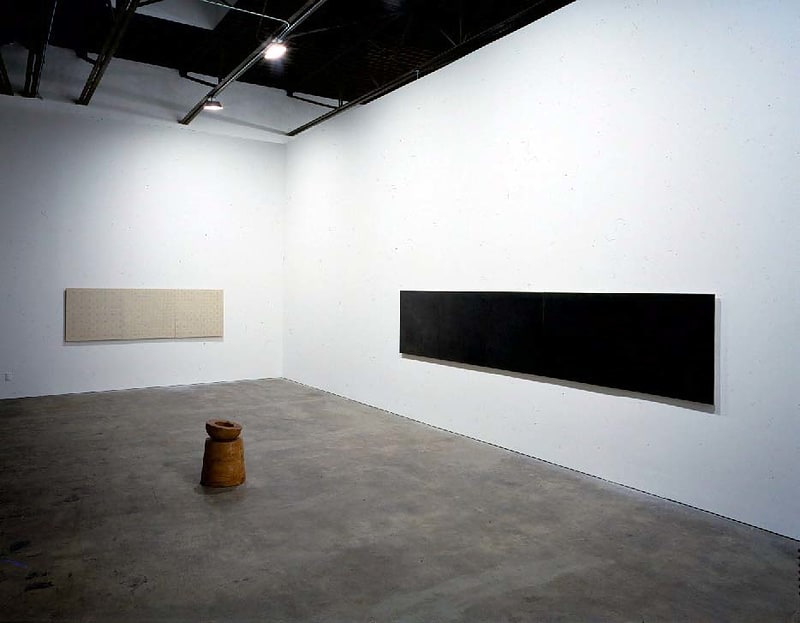
Nonprofit. SITE Santa Fe is a nonprofit contemporary arts organization based in Santa Fe, New Mexico. Since its founding in 1995, SITE Santa Fe has presented 11 biennials, more than 90 contemporary art exhibitions, and works by more than 800 artists. Following its presentation of the first international biennial of contemporary art in the U.S. SITE expanded its programming to include an ongoing exhibitions of notable artists in solo and group shows, often including new commissions and U.S. debuts. SITE presents acclaimed artists from all over the world while supporting New Mexico-based artists with significant career development and exhibition opportunities. Approximately 20% of exhibited artists are based in New Mexico.
SITE also presents public and educational programs related to the themes of each exhibition that include conversations with artists and curators, film screenings, performances, concerts, hands-on workshops, and collaborations with Santa Fe Public Schools. SITE partners with many local organizations and schools to develop and present its programs.[1]
Address: 1606 Paseo De Peralta, 87501-3724 Santa Fe
San Miguel Mission
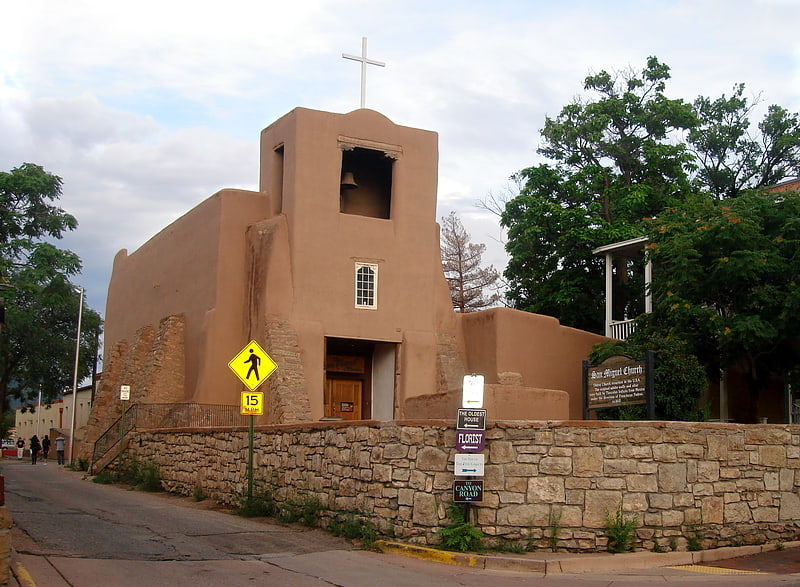
Art-filled adobe church from the 1600s. San Miguel Mission, also known as San Miguel Chapel, is a Spanish colonial mission church in Santa Fe, New Mexico. Originally built around 1610, it is often referred to as the oldest church in the United States, though it is likely that little of the original structure is still present. The church was rebuilt twice, once in the mid to late 17th century, and again in 1710 following the Pueblo Revolt. In both cases earlier pieces of the building may have been reused, though it is unclear to what extent. The wooden reredos, which includes a wooden statue of Saint Michael dating back to at least 1709, was added in 1798.
The church is a contributing property in the Barrio De Analco Historic District, which is a U.S. National Historic Landmark. As of 2020, weekly Mass is still offered at the chapel on Sundays.[2]
Address: 401 Old Santa Fe Trl, 87501 Santa Fe
Loretto Chapel
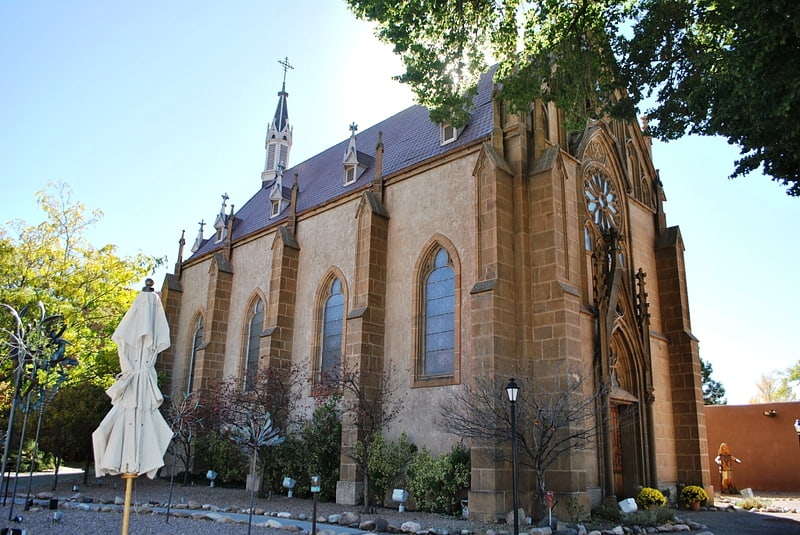
Historic site with legendary stairs. The Loretto Chapel in Santa Fe, New Mexico, USA, is a former Roman Catholic church that is now used as a museum and a wedding chapel.
It is known for its unusual helix-shaped spiral staircase (the "Miraculous Stair"). The Sisters of Loretto credited St. Joseph with its construction. It has been the subject of legend, and the circumstances surrounding its construction and its builder were considered miraculous by the Sisters of Loretto.[3]
Address: 207 Old Santa Fe Trail, 87501 Santa Fe
Palace of the Governors
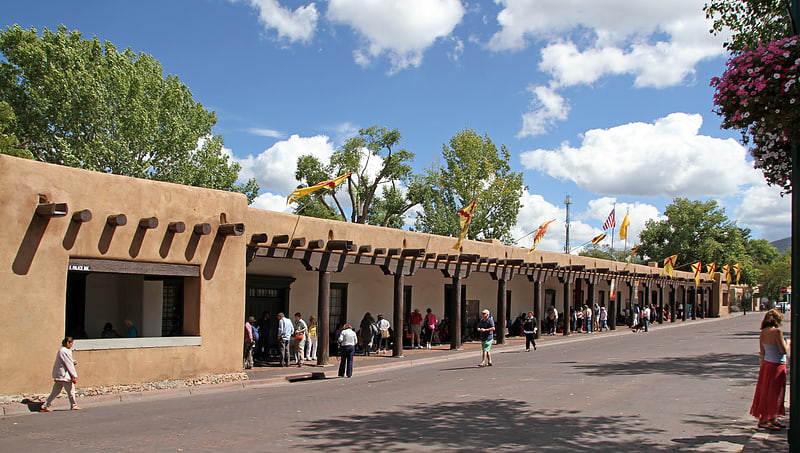
Exhibits showcasing the city of Santa Fe. The Palace of the Governors is an adobe structure built in the Territorial Style of Pueblo architecture on Palace Avenue in Santa Fe, New Mexico. Located within the Santa Fe Historic District along the Santa Fe Plaza between Lincoln and Washington avenues, it has served as the seat of government for New Mexico for centuries, having been established as the capitol building of Nuevo México in 1610.[4]
Address: 105 W Palace Ave, 87501-2014 Santa Fe
Santuario de Guadalupe
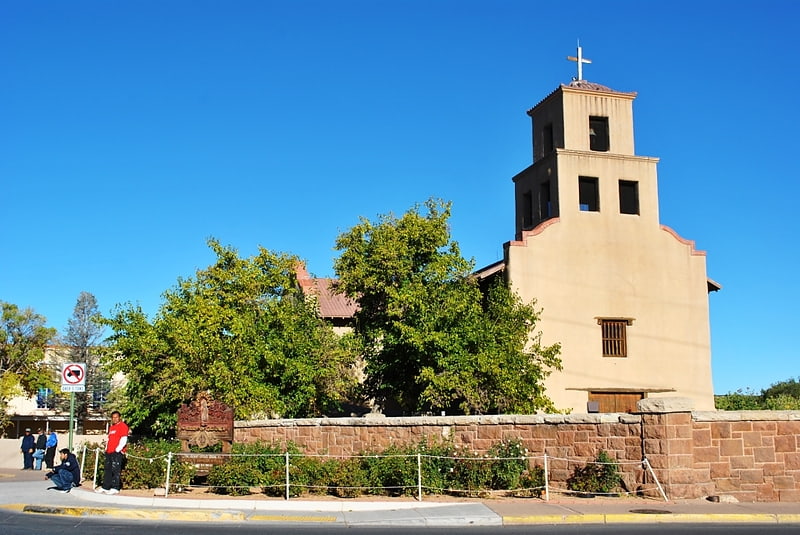
The Santuario de Nuestra Señora de Guadalupe is a historic Catholic shrine in Santa Fe, New Mexico. It is the oldest church in the United States dedicated to Our Lady of Guadalupe and is listed on the New Mexico State Register of Cultural Properties. It is also a contributing property in the Santa Fe Historic District.
The church is a simple cruciform building with thick adobe walls and has been remodeled several times, most recently in the 1970s.[5]
Address: 100 S Guadalupe St, 87501-5503 Santa Fe
Georgia O'Keeffe Museum
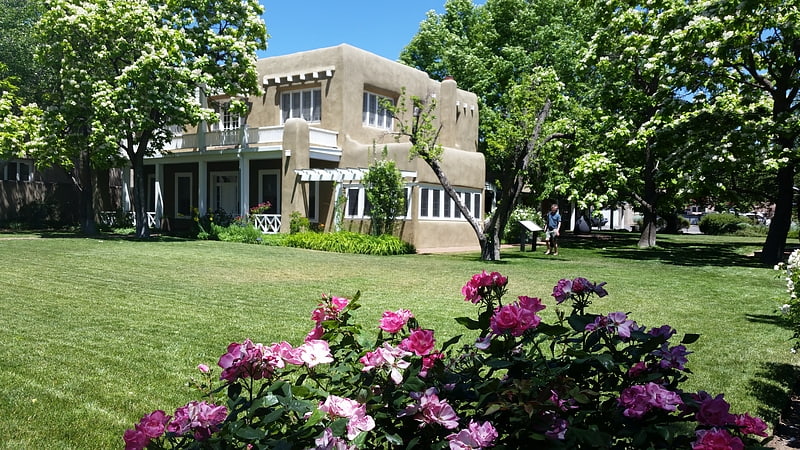
Museum in Santa Fe, New Mexico. The Georgia O'Keeffe Museum is dedicated to the artistic legacy of Georgia O'Keeffe, her life, American modernism, and public engagement. It opened on July 17, 1997, eleven years after the artist's death. It comprises multiple sites in two locations: Santa Fe, New Mexico, and Abiquiu, New Mexico. In addition to the founding Georgia O'Keeffe Museum in Santa Fe, the O'Keeffe includes: the Library and Archive within its research center at the historic A.M. Bergere house; the Education Annex for youth and public programming; Georgia O'Keeffe's historic Abiquiu Home and Studio; the O'Keeffe Welcome Center in Abiquiu; and Museum Stores in both Santa Fe and Abiquiu. Georgia O'Keeffe's additional home at the Ghost Ranch property is also part of the O'Keeffe Museum's assets, but is not open to the public.[6]
Address: 217 Johnson St, 87501-1826 Santa Fe
Cathedral Basilica of St. Francis of Assisi
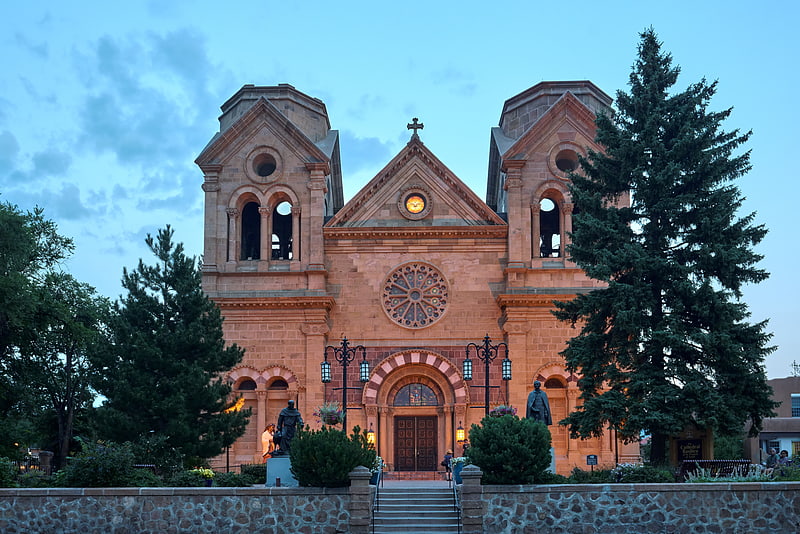
Cathedral in Santa Fe, New Mexico. The Cathedral Basilica of Saint Francis of Assisi, commonly known as Saint Francis Cathedral, is a Roman Catholic cathedral in downtown Santa Fe, New Mexico. It is the mother church of the Archdiocese of Santa Fe.
The cathedral was built by Archbishop Jean Baptiste Lamy between 1869 and 1886 on the site of an older adobe church, La Parroquia (built in 1714–1717). An older church on the same site, built in 1626, was destroyed in the 1680 Pueblo Revolt. The new cathedral was built around La Parroquia, which was dismantled once the new construction was complete. A small chapel on the north side of the cathedral was kept from the old church.
Influenced by the French-born Archbishop Lamy and in dramatic contrast to the surrounding adobe structures, Saint Francis Cathedral was designed in the Romanesque Revival style. As such, the cathedral features characteristic round arches separated by Corinthian columns and truncated square towers. The large rose window in front and those of the Twelve Apostles in the lateral nave windows were imported from Clermont-Ferrand in France. The towers were originally planned to be topped with dramatic 160-foot (49 m) steeples, but due to lack of funds, these were never built. The north tower is a single row of bricks taller than the south tower. The cathedral was built from yellow limestone blocks quarried near the present site of Lamy. A 2005 addition to the upper façade of the cathedral is a small, round window featuring a dove, the symbol of the Holy Spirit. It is a stained glass replica of the translucent alabaster window designed in the 17th century by the Italian artist Bernini for St. Peter's Basilica in Vatican City.
The Cathedral of Saint Francis of Assisi was officially elevated to a basilica by Pope Benedict XVI on October 4, 2005, when it was named the Cathedral Basilica of Saint Francis of Assisi.[7]
Address: 131 Cathedral Pl, 87501-2026 Santa Fe
Plaza Cafe

Historical landmark in Santa Fe, New Mexico. The Santa Fe Plaza is a National Historic Landmark in downtown Santa Fe, New Mexico in the style of traditional Spanish-American colonial cities. The plaza, or city square, was originally, and is still to this day, the center gathering place in town. Many know it as "the heart of Santa Fe". The landmark has since grown into a playground for many tourists interested in Spanish, Native American, and Mexican cultures, and includes music, design, jewelry, art and dance. It is home to annual events including Fiestas de Santa Fe, the Spanish Market, the Santa Fe Bandstand, and the Santa Fe Indian Market.
Listed on the National Register of Historic Places, the plaza consists of a central park lined with grass, trees, and benches. During Christmas time, the plaza is decorated with farolitos, luminarias, and trees lights. The park also includes a performing arts stage.[8]
Address: 100 Old Santa Fe Trail, 87501 Santa Fe
Museum of Indian Arts and Culture
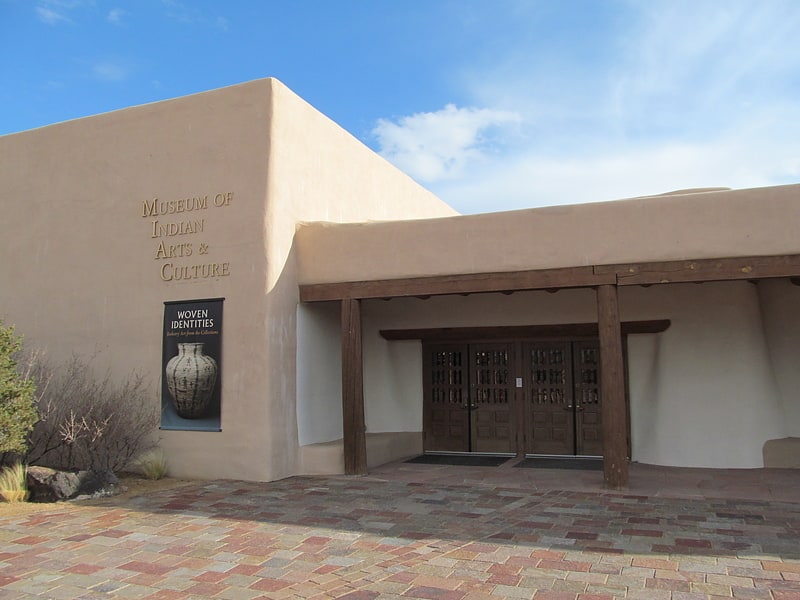
Museum in Santa Fe, New Mexico. The Museum of Indian Arts and Culture is a museum of Native American art and culture located in Santa Fe, New Mexico. It is one of eight museums in the state operated by the New Mexico Department of Cultural Affairs and is accredited by the American Alliance of Museums as part of the Museum of New Mexico system. The museum and its programs are financially supported by the Museum of New Mexico Foundation.
The Museum of Indian Arts and Culture is dedicated to the accurate and culturally sensitive presentation of southwestern Native American cultures. Its mission statement emphasizes its intention to work closely with the Native communities of the region. The current interim director is Dr. Matthew Martinez (Ohkay Owingeh). The prior director is Della Warrior (Otoe-Missouria).[9]
Address: 710 Camino Lejo, 87505-7511 Santa Fe
Santa Fe Opera

Opera company in Santa Fe County, New Mexico. Santa Fe Opera is an American opera company, located 7 miles north of Santa Fe, New Mexico. After creating the Opera Association of New Mexico in 1956, its founding director, John Crosby, oversaw the building of the first opera house on a newly acquired former guest ranch of 199 acres.
The company has presented operas each summer festival season since July 1957, and is internationally known for introducing new operas as well as for its productions of the standard operatic repertoire. Since its inception, Santa Fe Opera has staged 43 American premieres and 15 world premieres, as of 2017.[10]
Address: 301 Opera Dr, 87506-2823 Santa Fe
The Screen
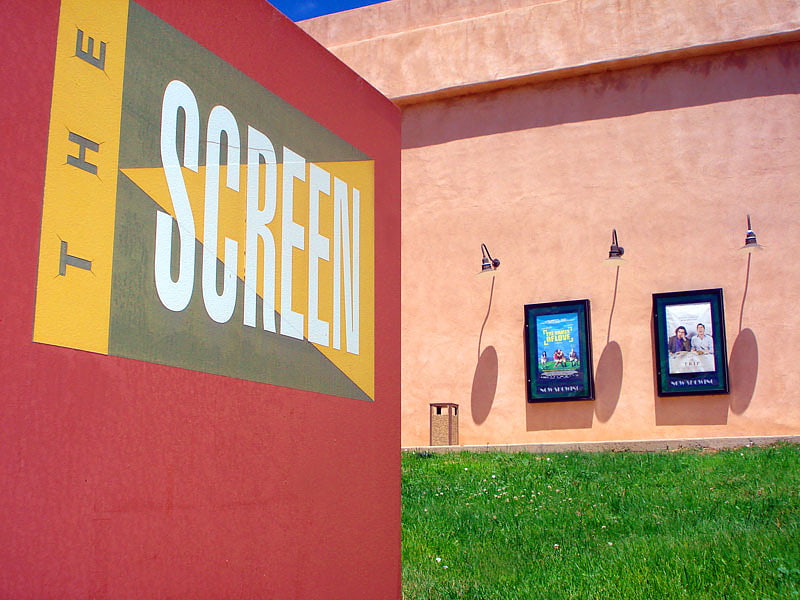
Movie theater in Santa Fe, New Mexico. The Screen is an arthouse cinema, open to the public, located on the midtown campus owned by the city of Santa Fe, New Mexico. Founded in 1999 and curated by Brent Kliewer, The Screen shows world, art, and independent cinema, as well as international performances of operas, ballets, and plays via satellite. It was used by the now-defunct Santa Fe University of Art and Design’s Moving Image Arts Department on the campus to show films for courses and student clubs.[11]
Address: 1600 St Michaels Dr, Santa Fe
Museum of International Folk Art
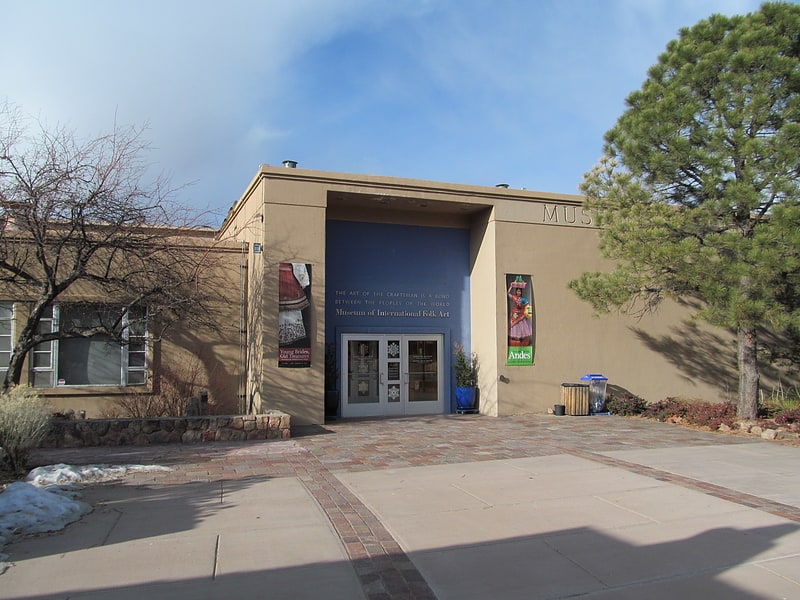
Cultural institute in Santa Fe, New Mexico. The Museum of International Folk Art is a state-run institution in Santa Fe, New Mexico, United States. It is one of many cultural institutions operated by the New Mexico Department of Cultural Affairs.[12]
Address: 706 Camino Lejo, 87505-7511 Santa Fe
El Rancho de las Golondrinas

Museum in La Cienega, New Mexico. El Rancho de las Golondrinas, a historic rancho and now a living history museum, is strategically located on what was once the Camino Real, the Royal Road that extended from Mexico City to Santa Fe. The ranch provided goods for trade and was a place where the caravans that plied the road would stop on their journey coming from or going to Santa Fe. It was a paraje, an official rest stop for travelers, and was even mentioned by the great colonial military leader and governor, Don Juan Bautista de Anza, when he stopped here with his expeditionary force in 1780.
El Rancho de las Golondrinas, located on 200 acres in the rural farming valley of La Ciénega just south of Santa Fe, New Mexico, strives to maintain examples of life during the period when Spain ruled in the southwestern portion of the North and most of the Central American continent. The museum opened in 1972 and is dedicated to the history, heritage and culture of 18th and 19th century New Mexico. Guides are dressed in period clothing and demonstrate weaving, hide tanning, milling, blacksmithing and the planting of crops. In addition to normal hours of operation there are ten annual festivals at El Rancho de las Golondrinas. Its acequia system (irrigation ditch complex) is on the Register of Historic Places for New Mexico.[13]
Address: 334 Los Pinos Rd, 87507-4363 Santa Fe
Jean Cocteau Cinema
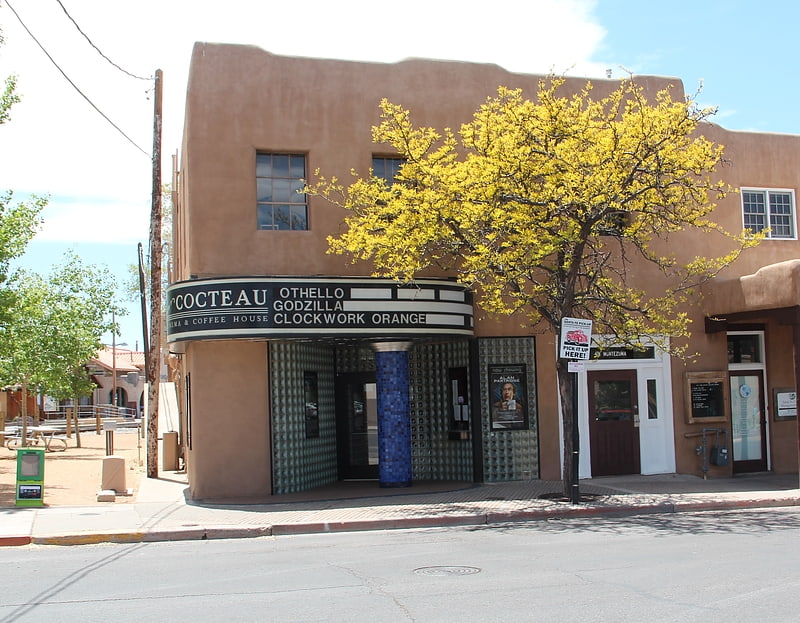
The Jean Cocteau Cinema is a historic movie theater located in Santa Fe, New Mexico, United States. It is owned by American author George R. R. Martin. In addition to films, the cinema hosts author talks and book-signings, along with a small display of signed books for sale; burlesque, magic and variety shows; art exhibitions and concerts.[14]
Address: 418 Montezuma Ave, Santa Fe
Lensic Performing Arts Center
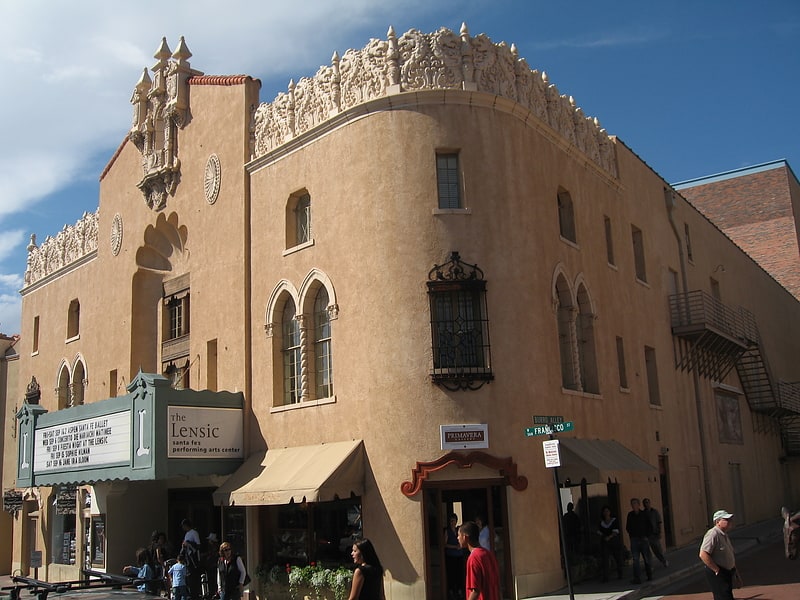
Theater in Santa Fe, New Mexico. The Lensic Theater, located at 211 West San Francisco Street in Santa Fe, New Mexico, is an 821-seat theater designed by Boller Brothers of Kansas City, well-known movie-theater and vaudeville-house architects who designed almost one hundred theaters throughout the West and mid-West, including the KiMo Theater in Albuquerque. The pseudo-Moorish, Spanish Renaissance Lensic was built by Nathan Salmon and E. John Greer and opened on 24 June 1931. Its name derives from the initials of Greer's six grandchildren.
The Lensic was completely restored and renovated between 1999 and 2001, and provides Santa Fe and Northern New Mexico with a modern venue for the performing arts.[15]
Address: Santa Fe, 211 West San Francisco Street
Cristo Rey Church
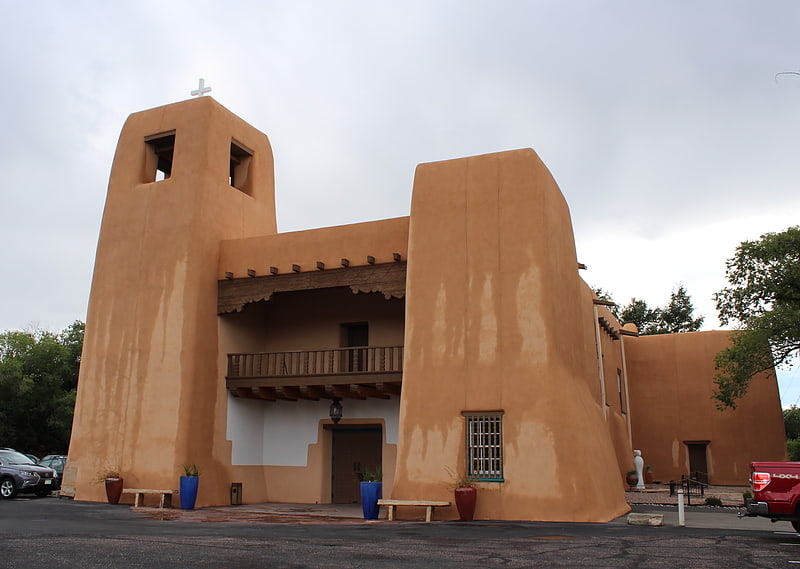
Cristo Rey Church is a Roman Catholic parish church on Canyon Road in Santa Fe, New Mexico. It is one of the most notable buildings designed by influential Santa Fe architect John Gaw Meem and is claimed by some sources to be the largest adobe building in the United States. It is also notable for its historic altar screen, the Reredos of Our Lady of Light, which is listed on the National Register of Historic Places. The reredos was carved in 1761 and originally hung in La Castrense, a military chapel on the Santa Fe Plaza. It has been described as "one of the most extraordinary pieces of ecclesiastical art in the country". The church was dedicated in 1940.[16]
Address: 1107 Cristo Rey Street, Santa Fe
New Mexico Museum of Art
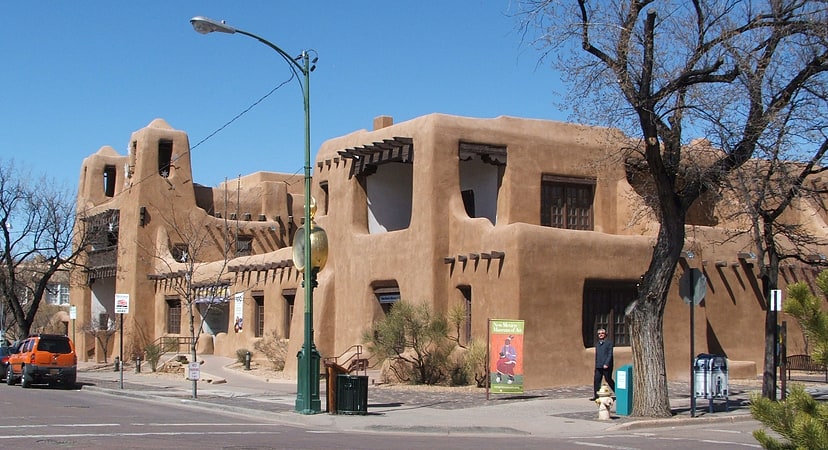
Museum in Santa Fe, New Mexico. The New Mexico Museum of Art is an art museum in Santa Fe governed by the state of New Mexico. It is one of four state-run museums in Santa Fe that are part of the Museum of New Mexico. It is located at 107 West Palace Avenue, one block off the historic Santa Fe Plaza. It was given its current name in 2007, having previously been referred to as The Museum of Fine Arts.[17]
Address: 107 W Palace Ave, 87501-2014 Santa Fe
El Zaguan
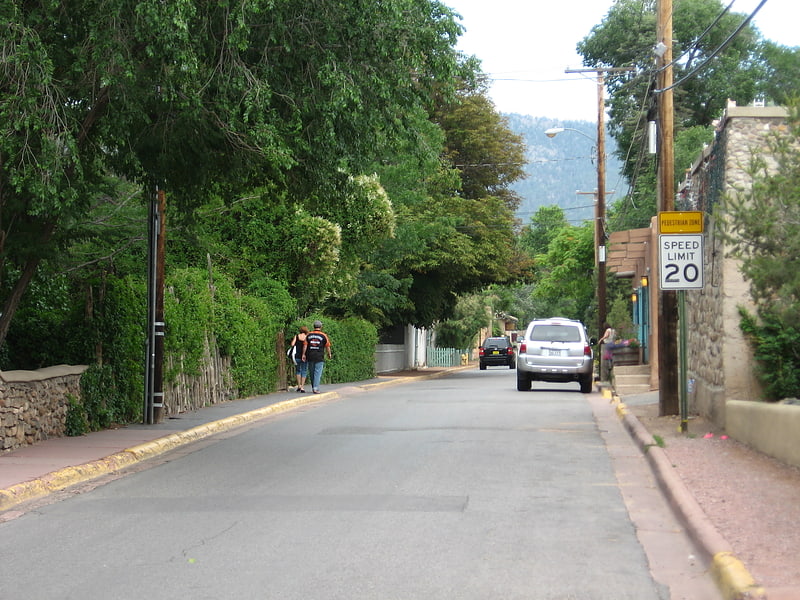
El Zaguan, at 545 Canyon Rd. in Santa Fe, New Mexico, is a historic complex started in 1854. It was listed on the National Register of Historic Places in 2008. The listing included two contributing buildings, three contributing structures, two contributing objects, and a contributing site on 1.8 acres.
It is Territorial Revival in style. A zaguan is a compound with a street doorway entrance usually leading back to a courtyard, which is surrounded by one-deep rooms.
This has also been known as the James L. Johnson House, and is a former residence of Margretta Stewart Dietrich, and later housed the Historic Santa Fe Foundation.
It was purchased in 1928 by Dietrich. Changes were made under direction of Santa Fe designer Kate Chapman.[18]
Address: 545 Canyon Road, Santa Fe
Lamy Building
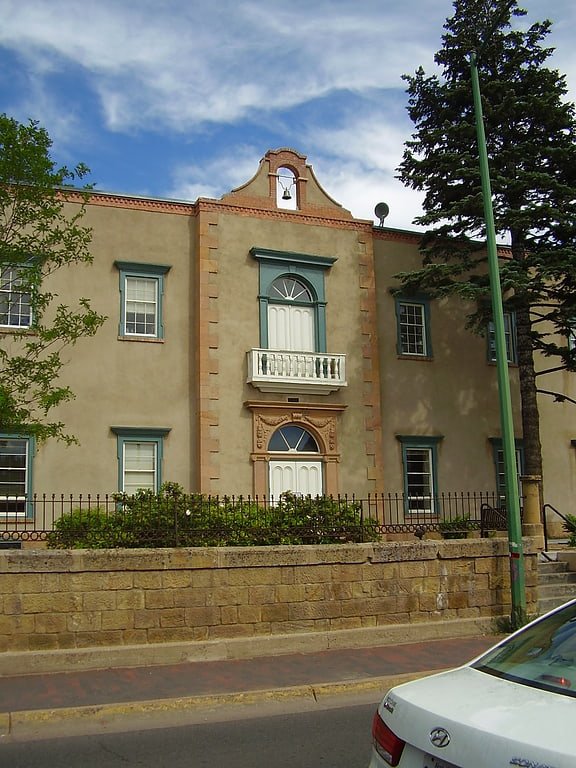
The Lamy Building, also known as St. Michael's Dormitory, is a historic building in Santa Fe, New Mexico. It was built in 1878 as the main building of St. Michael's College, the predecessor of St. Michael's High School and the College of Santa Fe. The building is a contributing property in the Barrio De Analco Historic District and currently serves as the headquarters of the New Mexico Tourism Department.[19]
Address: 413 Old Santa Fe Trail, Santa Fe
Wheelwright Museum of the American Indian
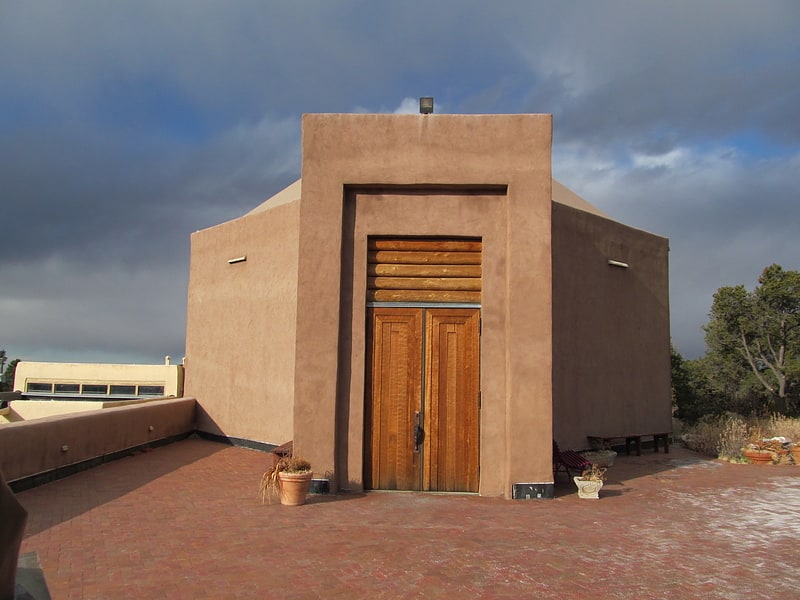
Museum in Santa Fe, New Mexico. The Wheelwright Museum of the American Indian is a museum devoted to Native American arts. It is located in Santa Fe, New Mexico and was founded in 1937 by Mary Cabot Wheelwright, who came from Boston, and Hastiin Klah, a Navajo singer and medicine man.[20]
Address: 704 Camino Lejo, 87505-7511 Santa Fe
Gregorio Crespin House

The Gregorio Crespin House, at 132 E. De Vargas St. in Santa Fe, New Mexico, was listed on the National Register of Historic Places in 1975. The listing included two contributing buildings. It has also been known as the Van Stone House.
It is an adobe structure started in the early 1700s. It consisted "of five rooms and a portal in 1867", and "was enlarged to twelve rooms by 1914 when the Van Stone family rented the house."[21]
Address: 132 East de Vargas Street, Santa Fe
New Mexico State Library
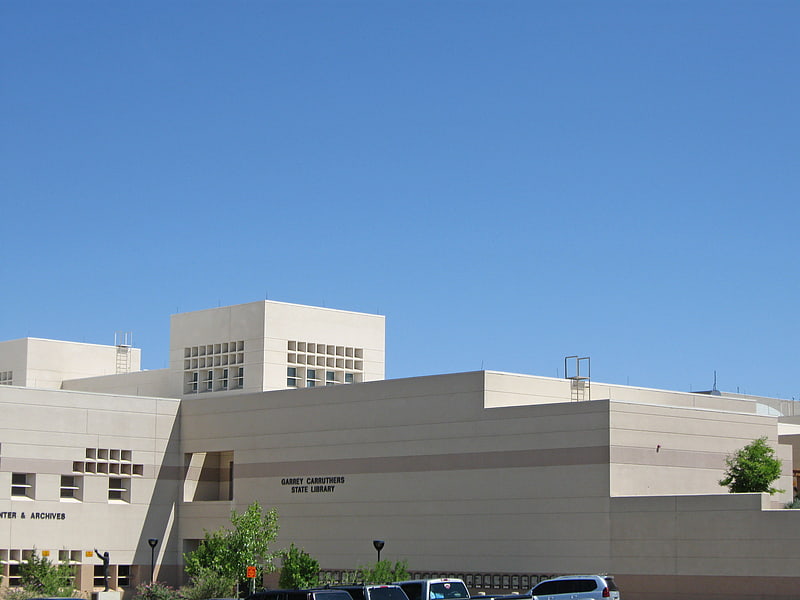
The New Mexico State Library is a government library in Santa Fe. It was established by the New Mexico legislature in 1961 from the library extension service that had previously been part of the Museum of New Mexico. Notable parts of the collection are the Southwest Collection and publications from the state and federal government. In addition to lending and preserving materials, the state library also provides funds to public libraries throughout New Mexico and runs a rural bookmobile.[22]
Museum of Contemporary Native Arts
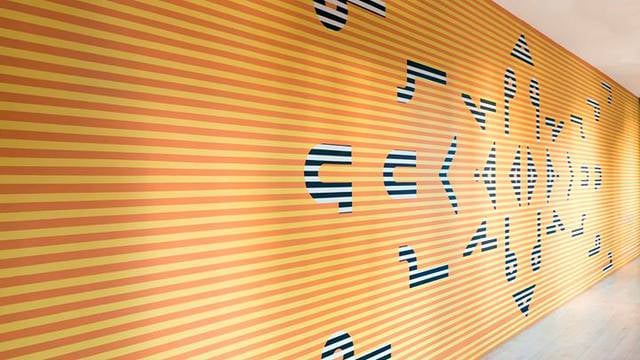
Museum, Natural history museum
Address: 108 Cathedral Pl, 87501-2027 Santa Fe
Don Gaspar Bridge
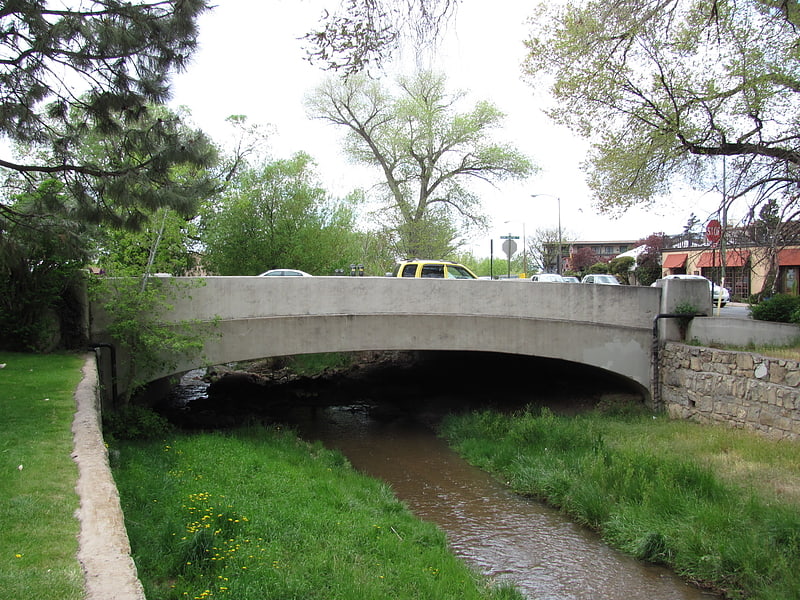
Bridge. The Don Gaspar Bridge, in Santa Fe, New Mexico, brings Don Gaspar Avenue over the Santa Fe River, between Alameda and E. De Vargas Streets. It was built in 1934. It was listed on the National Register of Historic Places in 2002.
The bridge's design introduced, to the area, use of reinforced concrete to make a thinner, more appealing appearance. Its layout was designed by state bridge engineer E.B. Van de Greyn.
It has also been known as El Puente de Los Conquistadores.[23]
Connor Hall

Connor Hall in Santa Fe, New Mexico is a Pueblo Revival-style building which was constructed in 1927 and 1928. Located at 1060 Cerrillos Rd. New Mexico School for the Deaf, it was listed on the National Register of Historic Places in 1988.
It was designed by architect George Williamson as an L-shaped building to serve as a dormitory. It is a three-story masonry and stucco building. It has "with irregular stepped massing, recessed fenestration, a flat roof and rounded parapets," and a recessed entryway "under a buttressed mission-like arch." Its bricks were made at the New Mexico State Penitentiary in Santa Fe.
The building was expanded to the rear in 1956 and 1957. It underwent a complete renovation in 1978 to plans by architect Charles Nolan.
The building was in use as a dormitory in 1987.[24]
Address: Cerrillos Road, Santa Fe
Alfred M. Bergere House
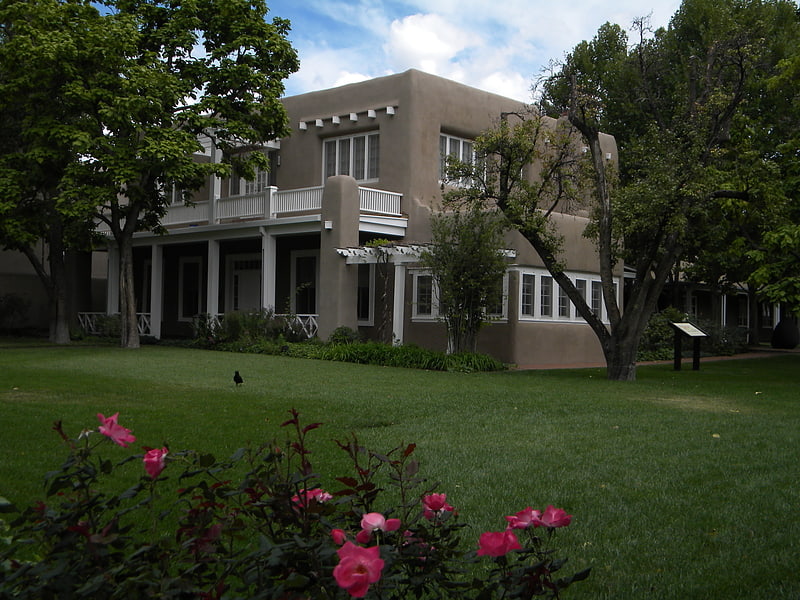
The Alfred M. Bergere House, at 135 Grant Ave. in Santa Fe, New Mexico, was built in the 1870s. It was listed on the National Register of Historic Places in 1975.
It has been in the Pueblo Revival style since a makeover in 1926.
It was built as am L-shaped adobe building. The house quartered General and former President U.S. Grant, Mrs. Grant, and Mrs. Fred Grant during their visit to the area in 1880.
It is significant as "one of two surviving Fort Marcy Military Reservation officer's residences in addition to being the home of a politically and socially prominent New Mexico family".[25]
Delgado Street Bridge
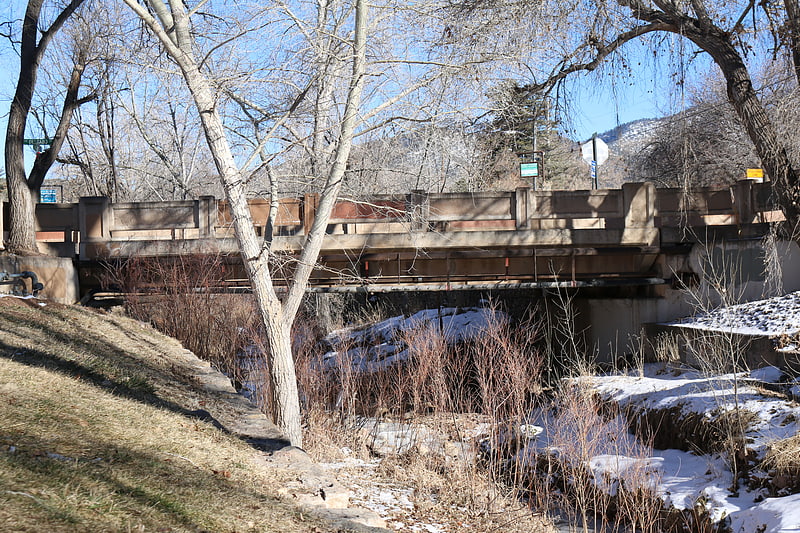
The Delgado Street Bridge, across the Santa Fe River in Santa Fe, New Mexico, was listed on the National Register of Historic Places in 2015. It is the oldest motor vehicle bridge in Santa Fe.[26]
New Mexico History Museum
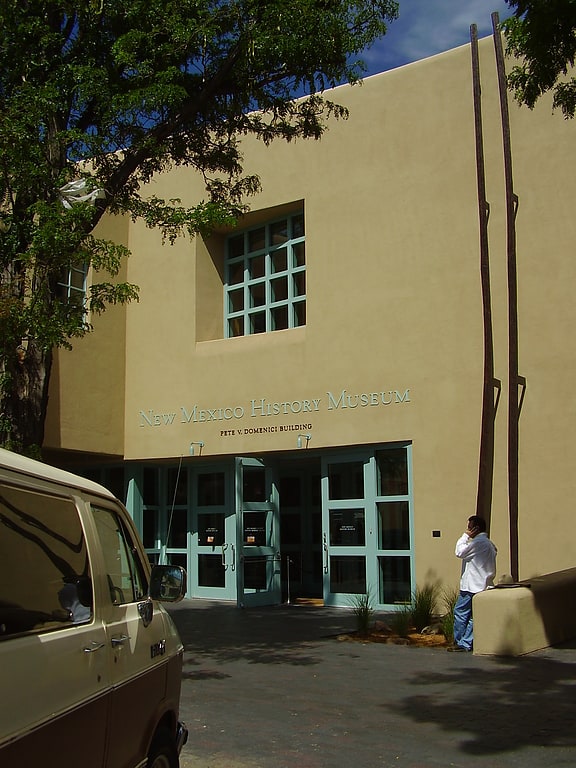
The New Mexico History Museum is a history museum in Santa Fe, New Mexico. It is part of the state-run Museum of New Mexico system operated by the New Mexico Department of Cultural Affairs. Opened in 2009, the museum houses 96,000 square feet of permanent and rotating exhibits covering the history of New Mexico from ancient Native American cultures to the present.
The museum was built after the Museum of New Mexico's collection of historic artifacts had outgrown its previous home at the 400-year-old Palace of the Governors. The new $44 million museum opened to the public on May 24, 2009, receiving more than 10,000 visitors on its first day. It holds around 20,000 artifacts.[27]
Address: 113 Lincoln Ave, 87501-2005 Santa Fe
Institute of American Indian Arts
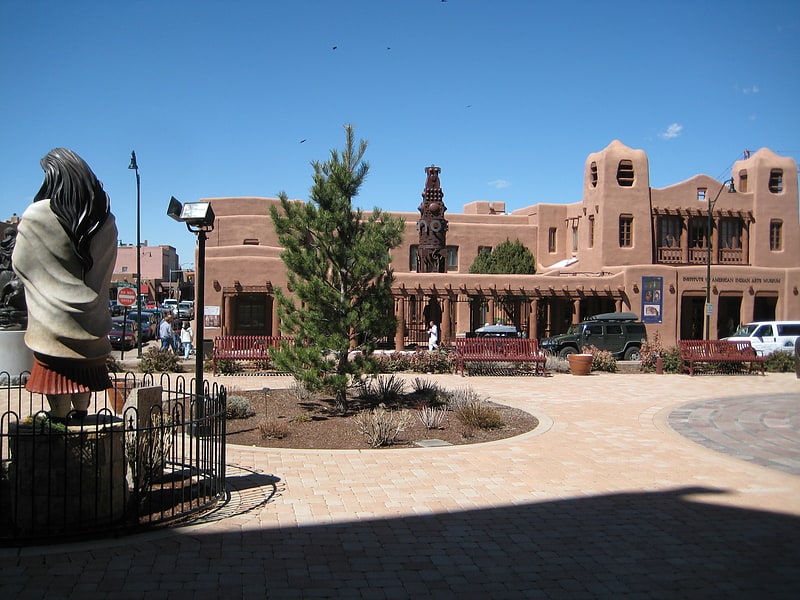
College in Santa Fe, New Mexico. The Institute of American Indian Arts is a public tribal land-grant college in Santa Fe, New Mexico. The college focuses on Native American art. It operates the Museum of Contemporary Native Arts, which is housed in the historic Santa Fe Federal Building, a landmark Pueblo Revival building listed on the National Register of Historic Places as Federal Building. The museum houses the National Collection of Contemporary Indian Art, with more than 7,000 items.[28]
Santa Fe Playhouse
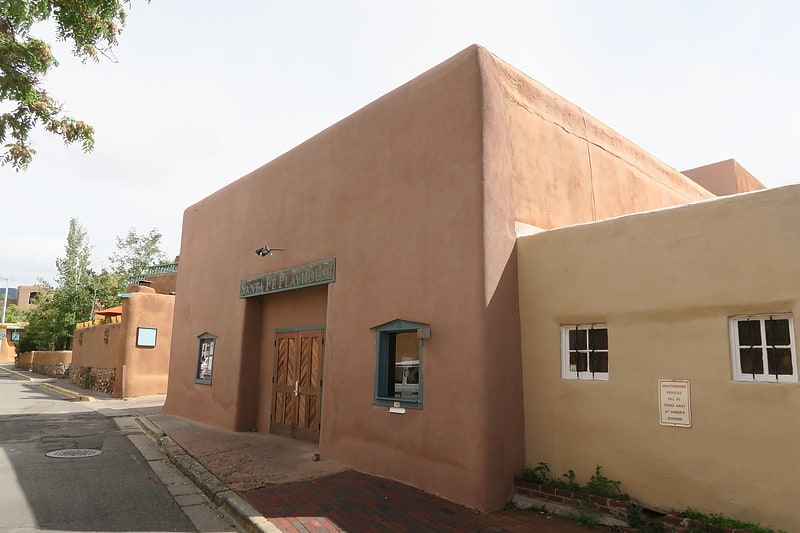
Performing arts theater in Santa Fe, New Mexico. Santa Fe Playhouse is a non-profit professional theater based in Santa Fe New Mexico. Founded in 1919 by American novelist and essayist Mary Hunter Austin as The Santa Fe Little Theatre and incorporated in 1922, it is “the oldest continuously running theatre west of the Mississippi.” The theater found a permanent home in 1962 located at 142 East De Vargas Street in Santa Fe, New Mexico in the heart of the Barrio De Analco Historic District.
Santa Fe Playhouse is currently led by Artistic Director Robyn Rikoon and Executive Director Colin Hovde.[29]
Address: 142 E de Vargas St, 87501-2702 Santa Fe
Fort Marcy
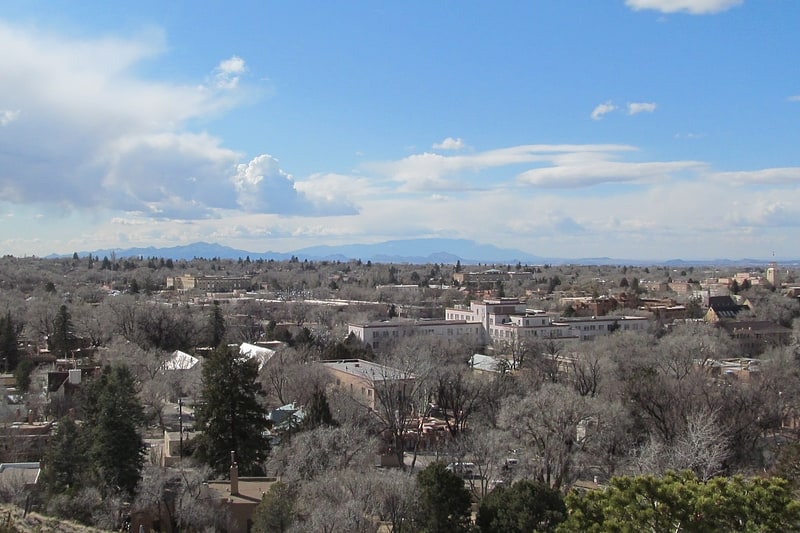
Fort Marcy was a military reservation in Santa Fe, New Mexico. Used during the American Civil War and Mexican–American War, the structure was demolished in the 1890s.[30]
Address: 617 Paseo de Peralta, 87501-1946 Santa Fe
Fairview Cemetery

Graveyard. Fairview Cemetery is a graveyard in Santa Fe, New Mexico. It was for many years the only non-Catholic cemetery in the city. There are roughly 3,700 people buried there. The graveyard is listed on the National Register of Historic Places.
The graveyard was established in its current location during the 1880s by James T. Newhall and Preston H. Kuhn. As declared in the opening entry of the Fairview Cemetery Company minutes, "The necessity of having and maintaining a proper place for burial of the dead in the town of Santa Fe, N. M. being apparent, Mr. James T. Newhall and Mr. Preston H. Kuhn made an estimate of the amount that would be required for the purpose..." The oldest gravestones date to the 1860s, belonging to people who were originally buried in the Masonic and Odd Fellows graveyard which used to be in downtown Santa Fe. Most of these bodies were moved to Fairview during the period 1895–1901.
Many Santa Fe residents who were prominent in their day are interred at Fairview, including Sylvanus Morley (1883-1948), Gerald Cassidy (1869-1934), Thomas B. Catron (1840-1921), Isabel Lancaster Eckles (1877-1971), Maximilian Frost (1852-1909), Luis Gold (1820-1880), Joseph Hersch (1822-1901), Napoleon Laughlin (1844-1924), Frank E. Mera, MD (1870-1970), Miguel Antonio Otero (1859-1944), John Pflueger (1864-1961), William J. Slaughter (1858-1905), Abraham Staab (1839-1913), Julia Staab (1844-1896), William Thornton (1843-1916), and Carlos Vierra (1876-1937).
The cemetery is now operated as a nonprofit organization by the Fairview Cemetery Preservation Association (FCPA). The FCPA holds its annual clean-up event in mid-May each year, followed by a general membership meeting. In early 2013, Fairview Cemetery staff oversaw construction of a cement wall several feet above and below grade to limit prairie dog intrusion into the cemetery.[31]
Meow Wolf
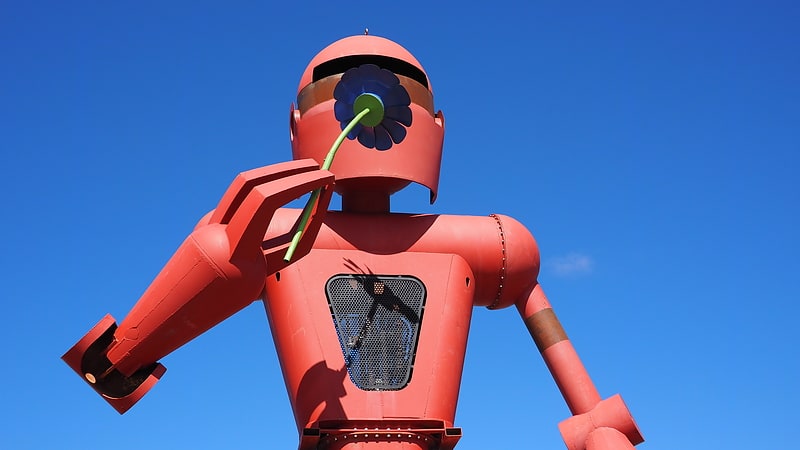
Meow Wolf is an American arts and entertainment company that creates large-scale immersive art installations as well as produces streaming content, music videos, and arts and music festivals. Founded in 2008, its flagship attraction, House of Eternal Return in Santa Fe, New Mexico, is a 20,000-square-foot facility, which includes an immersive art installation, learning center, and concert venue. In 2021 their second installation, Omega Mart, opened in Area15 in Las Vegas. A third location in Denver, Convergence Station, opened its doors to the public on September 17, 2021. The organization focuses on sharing abilities and processes among their artists to create elaborate maximalist art installations providing interactive and immersive art experiences. Meow Wolf is the entertainment industry's sole certified B corporation.[32]
Address: 1352 Rufina Cir, 87507-2927 Santa Fe
La Conquistadora
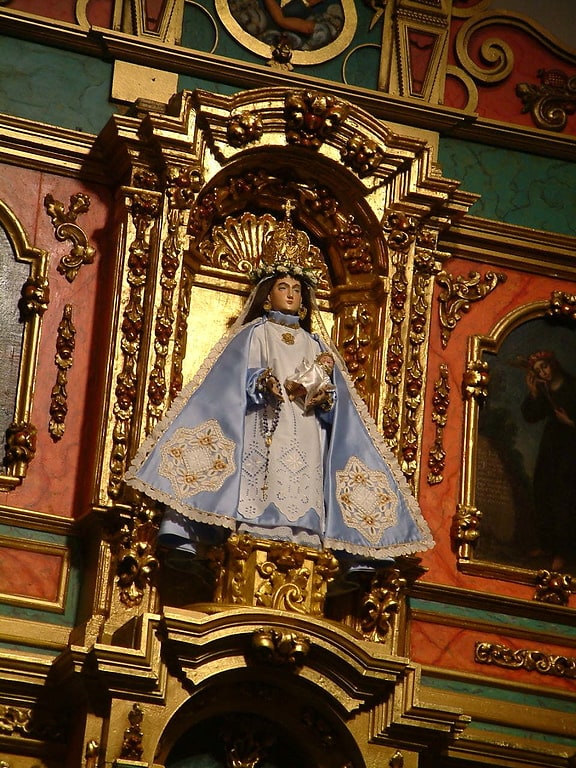
La Conquistadora is a small wooden statue of the Madonna and Child now in the Cathedral Basilica of St. Francis of Assisi in Santa Fe, New Mexico. She was the first Madonna brought to what is now the United States. The statuette is carved out of wood, and measures approximately three feet in height. A Catholic confraternity called, La Cofradía de La Conquistadora, exists to “promote devotion to the Mother of God under the title of La Conquistadora – Our Lady of Peace, and for the upkeep and maintenance of both of her chapels at the Cathedral Basilica of St. Francis of Assisi and the Rosario Chapel”. This confraternity is also responsible for maintaining the icon's chapel located in the north transept of the Basilica. The icon is dressed by the sacristana, or sacristan who maintains the vast wardrobe that includes clothing, veils, crowns, jewels and wigs. Cancer survivors often donate hair for use in fashioning wigs worn by the statue. The garments that the icon is clothed in are often sewn and donated by the faithful; all are rich in detail and very fine, often with elaborate designs. The estimate of her total outfits is close to 300. Even non-Catholics find occasion to honor the statue. For example, actress Ali MacGraw commissioned a piece that was displayed at Santa Fe's Spanish Colonial Museum in an exhibit about the icon mounted during 2010. The statue's origins are not well-known, but the 15th and 17th centuries are the most likely possibilities. Her arrival into America was made possible by the Spanish, who carried several versions of The Virgin Mary with them on their travels. There is a long history of armies carrying statues of saints into battle, for various purposes. Although the exact date of the statue's arrival in the New World is unknown, the Madonna was brought to New Mexico via Mexico City by priest Fray Alonso de Benavides, arriving in Santa Fe on January 25, 1626. Benavides wrote about this date in his journal, but the Archdiocese commonly uses the date of 1625. La Conquistadora was originally known as Our Lady of the Assumption.
Each new generation gave The Virgin a new title, with the current title being given to her by Don Diego de Vargas after he had reclaimed the area of Santa Fe 12 years after the Pueblo Revolt of 1680. He believed that La Conquistadora would help him in battle and offer assistance against the Native Americans who controlled the land. To give thanks to La Conquistadora, the Fiesta de Santa Fe is now held every August, in which she is carried in procession to Rosario Chapel and solemn masses are held in her honor (novena masses). Another title was given to the statue in 1992, when then-Archbishop Robert Sanchez bestowed her with the name Our Lady of Peace.[33]
Gerald Peters Gallery
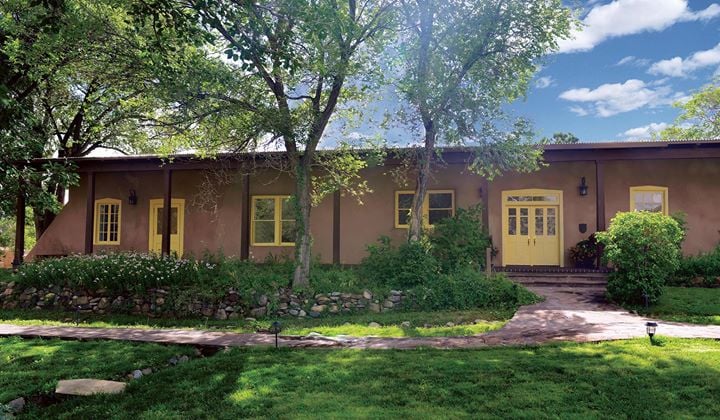
Museum, Art gallery, Shopping
Address: 1005 Paseo de Peralta, 87501-2735 Santa Fe